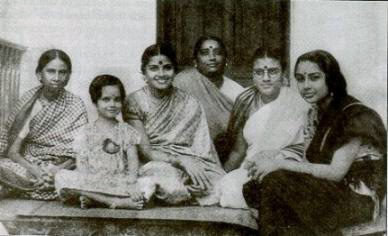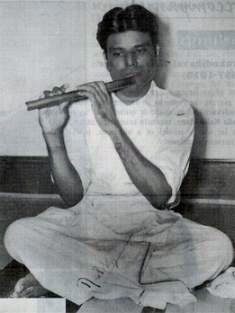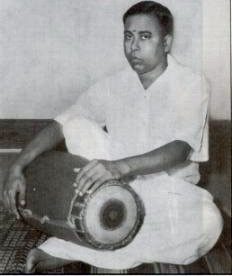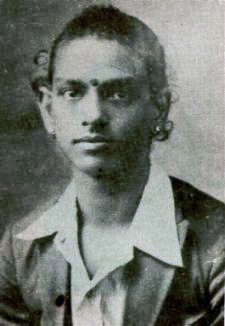by V.N. Muthukumar, Ram Naidu and M.V. Ramana
In this edition of the Carnatic Gallery, we discuss the ragas Khamas and Harikambodi. In addition to their intrinsic musical value, these two ragas illustrate how the two systems of Indian Classical Music differ in their treatments of an identical scale. We follow the standard convention in labeling the swaras [1].

From left: Veena Sanmugavadivu (mother of MS), Radha (Vishwanathan), MS Subbulakshmi, Lakshmi srinivasan, Vadivambal (sister of MS) and Kamala.
Raga Khamas
We begin with the raga Khamas. It is generally accepted that the raga is an adaptation of the Hindustani raga, Khamaj. It is termed a ‘desiya‘ raga [2] and belongs to the 28th mela, Harikambodi. The nominal Aarohana/avarohana is as follows:
S M1 G3 M1 P D3 N2 S”
S” N2 D3 P M1 G3 R2 S
Some call the raga sung in this scale as ‘Shuddha Khamas’, to distinguish it from the bhAshAnga version to be discussed shortly. The raga is a uttarAnga pradhAna raga and its jeeva swaras are M1 and D3. Note the vakra passage in the Arohana.
The form of the raga is established by phrases such as:
S M1 G3 M1, G3 M1 D3 P M1 G3 M1,
D3 N2 S” N2 D3 P M1 G3 M1, S” D3 P M1 G3 M1 etc.
In these phrases, the nyAsa swara is the M1 at the end, and it is applied as (G3)M1. The panchama can also be used as a nyAsa swara.
In contrast to the Hindustani Khamaj, the tAra shaDja is always approached by the prayoga D3 N2 S”. In the tAra stAyi, we commonly hear phrases such as:
S” N2 D3 N2 P D3, S” R2″ S”, S” N2 G3″ R2″ S”, S” G3 R2 S” N2 D3 etc.
Introducing the listener to Khamas, we first present a film song from the (Tamil) movie RAJA MUKTHI featuring M.K.Thyagaraja Bhagavathar. The composer is Papanasam Sivan, and the music director, G. Ramanathan.

T.R. Mahalingam (Mali)
Khamas is a very popular raga for padams and jAvalis. One of the earliest available pieces of composed music in Khamas is the Tamil Padam by Seerkazhi Muthu Thandavar [3] (ca. 17th century CE), teruvil vaarano. S. Balachander plays it on the veeNA.
Khamas is taught to every student through the swarajAti sambasivayanave. Interestingly, but perhaps not surprisingly, T. R. Mahalingam (“Mali”) plays it as an opening piece in an AIR concert.
Through his two kritis, Thyagaraja gave a classical touch to this raga. As a definition of Khamas, we present Thyagaraja’s sujana jeevana, sung by D. K. Pattammal [4]. Note how the identity of the raga is established by the very opening phrase. We also draw the attention of the listener to the phrase, S”–>P M1 G3 M1 that recurs throughout the kriti and sung delectably by DKP.
We now turn to Dikshitar‘s treatment of Khamas, as seen in the kriti sarasa dala nayana. In contrast to sujana jeevana, this kriti starts at the tAra stAyi. The raga mudrA is adroitly hidden in the kriti as a swarAkshara, and we leave it to the interested reader to uncover it. Note the beautiful phrase D3 N2 S” D3 N2 P D3 in the anupallavi. The musician is N. C. Vasantakokilam [5].
The two pieces above characterize the upAnga raga Khamas. However, in modern versions, the raga is considered bhAshAnga. Today, it is considered that the bhAshAnga nature emerges with the addition of N3. In this context, it is interesting to note what Subbarama Dikshitar [6] says in his Sangita Sampradaya Pradarshini. According to him, Khamas is a bhAshAnga raga, but he does not mention N3 as the bhAshAnga swara. Instead, he says, “… the swara G2 appears in the tAra stAyi prayogas such as S” R2″ (G2″)R2″ S”.

Palani Subramania Pillai
This is substantiated in his own varNam, sami ninne. This varNam is not very common in today’s stage and we present excerpts from a live concert of Musiri Subramania Iyer‘s at the Music Academy, Madras. T. Chowdiah accompanies him on the violin, Palani Subramania Pillai on the mridangam and Vilvadri Iyer on the ghaTam. Note that G2 appears as a subtle upward oscillation of R2″, rather than a flat note.
The modern version of Khamas is punctuated by the bhAshAnga swara N3. This swara is subservient to N2 and usually occurs in phrases such as S” N3 S”, S” N3 R2″ S”, and occasionally as P D2 N3 S”. Mysore Vasudevacharya‘s brochevarevarura is arguably the most popular kriti today. We present a breezy presentation of this song by G. N. Balasubramaniam, excerpted from an AIR Sangeet Sammelan concert. T. Chowdiah accompanies him on the violin, Palani Subramania Pillai on the mridangam, and Umayalpuram Kothandarama Iyer on the ghaTam. A brief sketch of the raga prefaces the kriti. Note that GNB uses N3 very sparingly in the anupallavi of the kriti and refuses to be drawn into it during the swara prastAra, despite Chowdiah’s insistence on PD2 N3 S”. We also draw the listener’s attention to the charaNam of the kriti where Palani launches into the misra nadai for a half Avartana and comes back to the chatusra, the change being effected as gracefully as only Palani can.
…followed by brochevarevarura.

A young G.N. Balasubramaniam
One of the best ways to learn the essentials of a raga is to learn a few varNams, as these pieces serve both as lakshaNA and lakshya for a raga. We are fortunate that a great modern composer chose Khamas for a very elaborate daru varNam [7]. Harikesanallur Muthiah Bhagavathar‘s matE malayadhwaja is a masterpiece in Khamas. The piece illustrates the use of M1 and D2, as well as the movement of swaras in the upper octave. In addition, Muthiah Bhagavathar’s genius finds expression in some uncommon phrases like N2 D2 P M1 G3 P M1, N2- M1 G3 M1 D2 N2, S M1 N2 G3 M1 (swarAkshara) S” N2, M1 N2 D2 G3″, N2 G3″ R2″ G3″ and a swift glide from S” to M1.
Accompanied by Kandadevi Azhagiriswami on the violin and T. K. Murthy on the mridangam, V. Nagarajan on the kanjirA and T. H. Vinakayaram on the ghaTam, M. S. Subbulakshmi opens a concert with Muthiah Bhagavathar’s daru varNam, matE malayadhwaja.
We conclude our discussion of Khamas with two short pieces. In the first, Madurai Mani Iyer sings Mayuram Vishwanatha Shastri‘s jayati jayati bharatha mata. The accompanists are Mayuram Govindaraja Pillai and Vellore Ramabhadran.
Muthiah Bhagavathar
We remarked earlier that Khamas is a favorite choice for padams and jAvalis. In this final clip, we listen to Charumati Ramachandran demonstrating the influence of Hindustani music on the rendering of the jAvali janaro. As her comments are in chaste Madras Tamil [8], a translation would be superfluous.
Raga Harikambodi
We now turn to the raga Harikambodi, one of the oldest ragas known.
The raga was the basic scale in the music of the sangam Tamils. The ‘yazh‘, a stringed instrument was tuned to produce the seven swaras S R2 G3 M1 P D2 N2. The resulting scale was called ‘Kodippalai’ [9]. Several authors have noted that this scale seems to have existed in other cultures, e.g., the mixolydian mode, the Arabic scale ‘djorka’ etc. Given that this scale was the fundamental scale of the ancient Tamils, it is hardly surprising that there are several Tevaram hymns sung in this raga. We hope to provide some recordings of these in a later column.
After the Tevaram hymns, it was Thyagaraja who resurrected this raga. The nominal scale is:
S R2 G3 M1 P D2 N2 S”
S” N2 D2 P M1 G3 R2 S.
It is a sampoorNa raga, and is the 28th melakarthA. All the notes of this raga can be considered jeeva swaras, though, in practice, the swaras R2 and N2 acquire more significance, and are oscillated often as (G3)R2 or (D2)N2. The dhaivata is used to launch typical uttarAnga sanchAras such as D2 N2 S”.
Some standard phrases are:
S N2_ D2_ N2_ S, S R2 S N2_ (D2_) N2_, S R2 G3-M1G3G3R2S, M1 P D2 N2
The phrase D2 N2 S is stressed repeatedly to move away from the territory of the raga’s more powerful janya, Kambodi. Harikambodi is closely allied to Khamas, but as will be evident from the clips to follow, it chooses to accentuate R2 and G3 by means of karvais.
The above features are best illustrated in the first of our clips.
We present one of the best vAggeyakArAs of our times, Tanjavur Sankara Iyer, singing his beautiful composition, muruga tirumal maruga. Note how the identity of the raga is established by the very first movements employing the phrases S R2 G3 and D2_ N2_ S. The melodic construction of each successive sangati in the pallavi and the anupallavi provides a lesson for the student on the elaboration of Harikambodi.
Among the modern composers, it was left to Papanasam Sivan to explore the path trodden by Thyagaraja. One of his best statements on Harikambodi is evidenced in the kriti, kamala pada malarinai, as Sanjay Subhramanyan [10] demonstrates.
Papanasam Sivan‘s genius is apparent in how he demonstrates a completely different approach to Harikambodi in his enadhu manam. D. K. Jayaraman presents this.
The melakartha raga Harikambodi has at least 50 janya ragas. A few examples are Kambodi, Natakurinji, Mohanam, Surati, Kedaragoula. Some of these ragas have become more popular than Harikambodi, the best example being Kambodi. Owing to this, one rarely hears an elaborate AlApana in Harikambodi. However, there are quite a few kritis in this raga offering excellent scope for the artiste’s imagination by means of neraval and swara prastAra.
One of the most popular pieces is Mysore Sadasiva Rao‘s saketa nagara natha where the line rajita amara pala is usually taken up for neraval and swaras. A classic example is presented, where we pick up G. N. Balasubramaniam initiating neraval. The accompanists are Lalgudi Jayaraman and Ramanathapuram C. S. Murugabhupathy, and the recording is an excerpt from a live concert at Pudukottai in 1964.
A short AlApana from a live concert featuring Alathur Brothers.
The kriti entuku nirdhaya follows. The vocalists, Alathur Subramania Iyer and Srinivasa Iyer are accompanied by Lalgudi Jayaraman on the violin, Palghat Mani Iyer on the mridangam and Pudukkotai Swaminatha Pillai on the kanjirA.
We conclude the feature by presenting a song that first appeared on the silver screen. It was composed by “Kalki” Krishnamurthy [11], one of the fathers of the Tamizh Isai movement, for the movie MEERA [12]. M. S. Subbulakshmi sings vandadum solai.
The various janya ragas of Harikambodi beginning with Kambodi deserve a feature by themselves. While Harikambodi is allied to the (Hindustani) Khamaj, Kambodi is sufficiently different. For these reasons, Kambodi and other janya ragas of Harikambodi will be presented in a later feature.
Acknowledgements
We thank Rajan Parrikar for motivating this feature, and making the audio clips.
References
[2] The term ‘desiya‘ carries different connotations depending on the context. One connotation is that the raga originates from folk music. Sometimes, the term also implies that the raga has its origins in other geographic regions, especially, the north. A third connotation is in the context of raga classification as ghana, naya, and desiya.
[3] On Muthu Thandavar and other pre-trinity Tamil composers see: https://www.geocities.com/CollegePark/5409/pret_tamil.html.
[4] https://www.india-today.com/itoday/15021999/profile.html.
[5] See: https://www.sangeetham.com/mc_vasanthakokilam.htm for a look at Vasantakokilam‘s film-singing career.
[6] See https://www.chembur.com/anecdotes/carnatic/sd.htm for a note on Subbarama Dikshitar and his treatise.
[7] The daru varNam is considered to have evolved from drama. It was used as a narrative piece. There are differing opinions on the etymology of the word ‘daru‘. One opinion is that the word is a corruption of ‘taru‘ (lit. tree) refering to the various limbs or angas of the composition. Typically, the daru has swaras, sollukattu, and sAhitya.
[8] Also called “English”, at times.
[9] While there is unanimity on the finding that the ‘yazh‘ was tuned to produce the Harikambodi scale, there is some difference in the literature as to the precise mapping of ‘Kodippalai’ to a modern scale. N. Mukund, (Sangeetha Laalithya Lahiri, Bangalore, 1989) identifies Kodippalai with Harikambodi. So does S. Rajam in Sruti, 17, 39 (1985). On the other hand, V. Premalatha (Music through the ages, Sundeep Prakashan, New Delhi, 1985) identifies Kodippalai with Sankarabharanam.
[10] https://members.tripod.com/~sanjaysub.
[11] For a biographical sketch of Kalki, see: https://ponniyinselv.users3.50megs.com/page5.html.
[12] The making of the movie MEERA has been documented in https://www.sangeetham.com/meera.htm.
Ram Naidu learns the Veena from Smt. Vidya Shankar. He is currently at Analogic Corporation.
M. V. Ramana is currently at the Program on Science and Global Security, Princeton University.
Go back to In the Khamaj Orchard.
